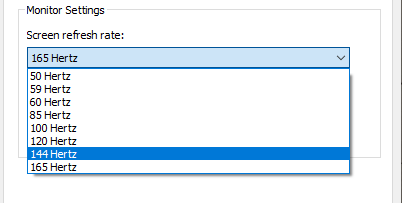When it comes to gaming, one of the best investments you can make is a high refresh rate monitor (144Hz or higher); Games look and feel much smoother, aiming can feel more precise, feedback from your inputs feels more immediate, and you can react faster due to reduced latency and blur.
Generally, the higher the refresh rate the smoother the experience.
What is Refresh Rate?

Refresh rate is rated in Hertz or ‘Hz’. It is a metric used to quantify how many times something occurs in a second. In terms of computer monitors, it’s the number of times the display is updated with new information.
To illustrate:
- A 1Hz monitor would refresh a new image every second.
- A 60Hz monitor would refresh a new image 60 times in a second.
- A 144Hz monitor would refresh a new image 144 times in a second.
In general, higher refresh rates are associated with better image quality.
Frame Rate vs Refresh Rate
Both frame rate and refresh rate are measures of how many times a still image is displayed per second. Frame rate is measured in Frames per Second or FPS and refresh rate is measured in Hertz or Hz.
It’s important to understand that FPS and refresh rate are not the same thing. FPS is the number of images being generated by your GPU. Frame rate is how quickly the display updates the image with new information.
The greater the FPS/Frame Rate, the more fluid/smooth an image appears and the better the illusion of movement
Is FPS Limited by Refresh Rate?
No.
FPS is simply how many frames your GPU is producing where-as refresh rate is how many times the monitor is refreshing the image on the screen.
The refresh rate of the monitor does not effect the FPS being output by the GPU. Monitor refresh rate affects the maximum frame rate that can be effectively displayed.
Refresh rate essentially dictates the limit as to how many frames can be shown to the user, per second. It has no effect on how fast your GPU can render an image.
To illustrate:
Assume your GPU outputs 120 FPS and you have a 60 Hz monitor; You would effectively only see 60 frames. This situation is also the cause of a phenomenon referred to as “screen tearing.”
Screen Tearing
In a computer the Graphics Processing Unit (GPU) is responsible for rendering the images on the monitor/display. Depending on the hardware specifications of the GPU and the application, it can render a number of frames per second.
The GPU sends this information to the display. The displays panel technology then determines the frequency of transition per image or refresh rate.
Disparity between the GPU’s FPS and refresh rate (Hz) results in screen tearing; The frame rate exceeds the monitor’s refresh rate.
Screen tearing happens when two frames are drawn on the display at once which creates a “tear” between the frames in the form of horizontal line(s).
Which Refresh Rate Should You Use, 60Hz or 144 Hz?
The answer depends on your application. If your application requires low latency and responsiveness like gaming then 144 Hz is recommended.
If your application is for something static like word processing, browsing the internet, and email, 60 Hz will suffice.

